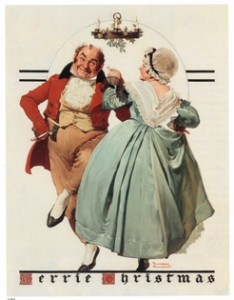
"Merrie Christmas: Couple Dancing Under Mistletoe," Norman Rockwell, 1928. Oil on canvas. Cover illustration for "The Saturday Evening Post," December 8, 1928.
(STOCKBRIDGE, Mass.) – This holiday season Norman Rockwell Museum celebrates the 200th anniversary of Charles Dickens’ birth with a new exhibition that explores the literary giant’s influence on the artist’s work. Norman Rockwell and the Ghost of Dickens is on view at the museum through March 4, 2012.
Norman Rockwell is well known for his enduring illustrations of the holidays, which brought good cheer to millions of Americans. In his autobiography, My Adventures as an Illustrator, the artist described important memories from his youth that were seminal to his later work. Of particular importance were Rockwell’s recollections focused on his father reading Charles Dickens stories aloud to his sons in the evening after they finished their homework. Throughout his life, Rockwell would cite the significance of those nightly readings and the influence of Dickens on his art.
“Charles Dickens provided a great lexicon of human experience and personality types for Norman Rockwell to explore,” notes Joyce K. Schiller, Ph.D, who curated the exhibition. “He also inspired the artist’s portrayal of Dickensian characters throughout his career.”
Norman Rockwell and The Ghost of Dickens presents a rare opportunity to view a collection of original Rockwell artwork from both the museum and private collections. Highlights include Dickens-inspired drawings from Rockwell’s autobiography; the 1937 Reader’s Digest painting, “A merry Christmas to everybody! A happy New Year to all the world!”; and original oil on canvas paintings for such classic Saturday Evening Post covers as “Christmas Trio” (1923), “Merrie Christmas: Couple Dancing under Mistletoe” (1928), and “Tiny Tim and Bob Cratchit (God Bless Us Everyone)” (1934). Original cover tear sheets and charcoal studies will also be on view, further illustrating the artist’s elaborate process in creating his work.
Norman Rockwell once remarked that “(Charles) Dickens wrote about the kind of people I paint.” In Rockwell’s Dickens-inspired view of life, his neighbors served as important references for his art, compelling “types” in his visual narratives. A device the artist used in his illustrations, for which he credited the author, was the placement of tragedy and comedy together, believing that when used jointly in a work of art, an image would have a greater impact on its viewers. In his autobiography, the artist wrote, “The variety, sadness, horror, happiness, treachery, the twists and turns of life… in Dickens shocked and delighted me.”
Norman Rockwell Museum is located on 36 park-like acres in Stockbridge, Mass., Rockwell’s hometown for the last 25 years of his life. The museum is open year-round; closed Thanksgiving, Christmas, and New Year’s Day. From May through October, hours are 10 a.m. to 5 p.m. daily; from November through April, hours are 10 a.m. to 4 p.m. Monday through Friday, and 10 a.m. to 5 p.m. on weekends and holidays. Rockwell’s studio is open May through October, 10 a.m. to 5 p.m. Museum admission is $16, $14.50 for seniors, $10 for students, $5 for kids and teens 6 to 18, and free for Museum members and children 5 and under. Visit the Museum online at Norman Rockwell Museum.
